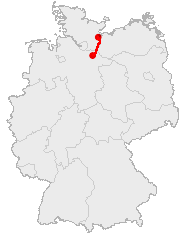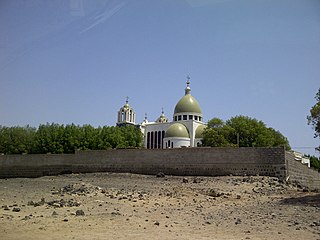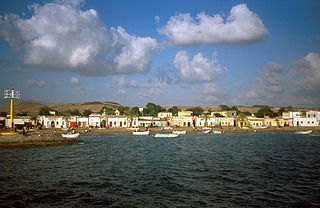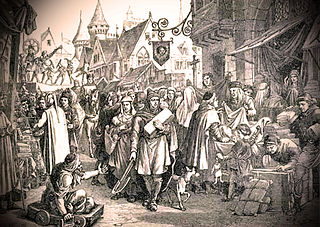
The Old Salt Route was a medieval trade route in Northern Germany, one of the ancient network of salt roads which were used primarily for the transport of salt and other staples. In Germany it was referred to as Alte Salzstraße.

Lüneburg, officially the Hanseatic City of Lüneburg and also known in English as Lunenburg, is a town in the German state of Lower Saxony. It is located about 50 km (31 mi) southeast of another Hanseatic city, Hamburg, and belongs to that city's wider metropolitan region. The capital of the district which bears its name, it is home to roughly 77,000 people. Lüneburg's urban area, which includes the surrounding communities of Adendorf, Bardowick, Barendorf and Reppenstedt, has a population of around 103,000. Lüneburg has been allowed to use the title "Hansestadt" in its name since 2007, in recognition of its membership in the former Hanseatic League. Lüneburg is also home to Leuphana University.

The Adal Sultanate also known as the Adal Empire, or Bar Saʿad dīn was a medieval Sunni Muslim Empire which was located in the Horn of Africa. It was founded by Sabr ad-Din III on the Harar plateau in Adal after the fall of the Sultanate of Ifat. The kingdom flourished c. 1415 to 1577. At its height, the polity under Sultan Badlay controlled the territory stretching from Cape Guardafui in Somalia to the port city of Suakin in Sudan. The Adal Empire maintained a robust commercial and political relationship with the Ottoman Empire. Sultanate of Adal was alternatively known as the federation of Zeila.

Adwa is a town and separate woreda in Tigray Region, Ethiopia. It is best known as the community closest to the site of the 1896 Battle of Adwa, in which Ethiopian soldiers defeated Italian troops, thus being one of the few African nations to thwart European colonialism. Located in the Central Zone of the Tigray Region, Adwa has a longitude and latitude of 14°10′N38°54′E, and an elevation of 1907 meters. Adwa is surrounded by Adwa woreda.

Roanne is a commune in the Loire department, central France.

Assab or Aseb is a port city in the Southern Red Sea Region of Eritrea. It is situated on the west coast of the Red Sea. Languages spoken in Assab are predominantly Afar,Amarigna Tigrinya, and Arabic. After the Italian government took control of the port in 1882, it laid the foundations for the formation of the colony of Italian Eritrea, which became the independent country of Eritrea following its independence from Ethiopia in the 1990s.

A salt evaporation pond is a shallow artificial salt pan designed to extract salts from sea water or other brines. The salt pans are shallow and expansive, allowing sunlight to penetrate and reach the seawater. Natural salt pans are formed through geologic processes, where evaporating water leaves behind salt deposits. Some salt evaporation ponds are only slightly modified from their natural version, such as the ponds on Great Inagua in the Bahamas, or the ponds in Jasiira, a few kilometres south of Mogadishu, where seawater is trapped and left to evaporate in the sun.

Trans-Saharan trade is trade between sub-Saharan Africa and North Africa that requires travel across the Sahara. Though this trade began in prehistoric times, the peak of trade extended from the 8th century until the early 17th century CE. The Sahara once had a different climate and environment. In Libya and Algeria, from at least 7000 BCE, pastoralism, large settlements and pottery were present. Cattle were introduced to the Central Sahara (Ahaggar) between 4090 to 3500 BCE. Remarkable rock paintings in arid regions portray flora and fauna that are not present in the modern desert.

Salt, also referred to as table salt or by its chemical formula NaCl, is an ionic compound made of sodium and chloride ions. All life depends on its chemical properties to survive. It has been used by humans for thousands of years, from food preservation to seasoning. Salt's ability to preserve food was a founding contributor to the development of civilization. It helped eliminate dependence on seasonal availability of food, and made it possible to transport food over large distances. However, salt was often difficult to obtain, so it was a highly valued trade item, and was considered a form of currency by certain people. Many salt roads, such as the Via Salaria in Italy, had been established by the Bronze Age.

Tadjoura is one of the oldest towns in Djibouti and the capital of the Tadjourah Region. The town rose to prominence in the early 19th century as an alterative port to nearby Zeila. Lying on the Gulf of Tadjoura, it is home to a population of around 45,000 inhabitants. It is the third-largest city in the country after Djibouti and Ali Sabieh.

Leintz Gatzaga is a town located in the province of Gipuzkoa, in the Autonomous Community of Basque Country, northern Spain. The municipality's population is 251 (2015).

Tende is a commune in the Alpes-Maritimes department in southeastern France.

Open-pan salt making is a method of salt production wherein salt is extracted from brine using open pans.

Debarq also spelled Dabareq and Debark, is a town in northern Ethiopia, 90 kilometers north-east of Gondar on the highway between Gondar and Axum, and is in the Semien Gondar Zone of the Amhara Region. It has a latitude and longitude of 13°08′N37°54′E and an elevation of 2850 meters above sea level.

A caravan or cafila is a group of people traveling together, often on a trade expedition. Caravans were used mainly in desert areas and throughout the Silk Road, where traveling in groups aided in defense against bandits as well as helped to improve economies of scale in trade. Some of the first caravans on the Silk Road were sent out by Emperor Wu of Han in the 2nd century BCE when this vast network of roads was 'born', and as China began exporting large quantities of silk and other goods west, particularly destined for the Roman Empire.

The Champagne fairs were an annual cycle of trade fairs which flourished in different towns of the County of Champagne in Northeastern France in the 12th and 13th centuries, originating in local agricultural and stock fairs. Each fair lasted about 2 to 3 weeks. The Champagne fairs, sited on ancient land routes and largely self-regulated through the development of the Lex mercatoria, became an important engine in the reviving economic history of medieval Europe, "veritable nerve centers" serving as a premier market for textiles, leather, fur, and spices. At their height, in the late 12th and the 13th century, the fairs linked the cloth-producing cities of the Low Countries with the Italian dyeing and exporting centers, with Genoa in the lead, dominating the commercial and banking relations operating at the frontier region between the north and the Mediterranean. The Champagne fairs were one of the earliest manifestations of a linked European economy, a characteristic of the High Middle Ages.
ʿAydhab was an important medieval port on the west coast of the Red Sea. The abandoned site of the town is located in the Halaib Triangle, a territory disputed between Egypt and the Sudan.

Slavery in Ethiopia existed for centuries, going as far back as 1495 BC and ending in 1942. There are also sources indicating the export of slaves from the Aksumite Empire. The practice formed an integral part of Ethiopian society. Slaves were traditionally drawn from the Nilotic groups inhabiting Ethiopia's southern hinterland and Oromos. War captives were another source of slaves, though the perception, treatment and duties of these prisoners was markedly different. Although religious law banned Christian slave masters from taking part in the slave trade, many Muslim Ethiopian slave traders took part in the Arab slave trade. Slaves usually served as concubines, bodyguards, servants and treasurers.

The Matsumoto Kaidō (松本街道), also known as the Chikuni Kaidō (千国街道), the Itoigawa Kaidō (糸魚川街道) or simply as the Shio-no-michi (塩の道) was a secondary road in pre-modern Japan, connecting Matsumoto in Shinano Province with Itoigawa in Echigo Province). In the year 2002, a well-preserved 20-kilometer section of the original path in the city of Itoigawa was designated a National Historic Site of Japan, and an additional 10-kilometer section was added in 2007.
The economy of the Ethiopian Empire was dominated by the barter system, traditionally composed of Arab and Ethiopian Muslim caravans, and a strong trade culture nourished business within the feudal system. In medieval times, neighboring state Emirate of Harar became the center of commerce while imports and exports passed through the port of Zeila, operated by Muslim merchants, delivering commodities to the Abyssinians through Aliyu Amba a town in Ifat, which connected the Shewa.



















